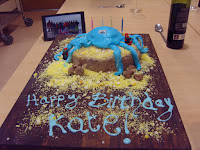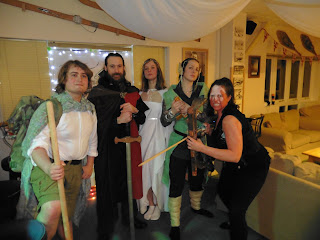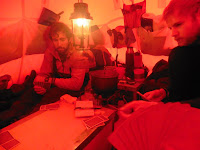Hello, and welcome back to my blog!
Things certainly shifted to a slower pace as we stepped into winter, and with it we have settled into a more relaxed routine. It is hard to believe that in only three weeks we will have strangers back on base, and aircraft operating on our front door.
Since my last update, we welcomed the last aircraft of the winter through Rothera, as a brave crew made it's way to the South Pole for a medical evacuation on midwinter's day. Traditionally a major celebration at Antarctic bases, we were all on hold for the week in order to help the operation run as smoothly as possible. We very happily celebrated it's unprecedented success along with midwinters the very next week. A bit more information on the incredible feat and the two Canadian crews can be found here:
https://www.washingtonpost.com/news/speaking-of-science/wp/2016/06/16/a-rare-risky-mission-is-underway-to-rescue-sick-scientists-from-the-south-pole/?postshare=371466177429545&tid=ss_mail
and here:
https://www.nsf.gov/news/news_summ.jsp?cntn_id=139028&org=NSF&from=news
I could go on quite a bit about this event, but all I really want to say is how comforting and inspiring it was to see how, despite everything, so many people worked together to help rescue two humans from the very end of the world on the very shortest day of the year. There is some humanity left, no matter how senseless things have seemed recently.
On a brighter note, it is almost needless to say that once that mission was completed we very happily celebrated both that AND our passing of the solstice, the slow return of daylight.
 |
| Thank you Ali Rose for the group photo! |
With exactly one week delay, the celebrations began with some time off and some organised activities. The morning of midwinters we had the infamous gift exchange, where we each gave a gift we'd been working on since the ship left to another member of the team. The standard of the gifts was absolutely amazing, ranging from oil paintings to chairs, votive lamps to knives and everyone was absolutely beaming when opening their gift.

After a short pause to clean up a bit, we returned for the feast. And what a feast it was! Our chef, Lewis, absolutely spoiled us with the help of some special thank you ingredients from the chef at the South Pole (it sometimes seems like a large family you haven't met the 9/10ths of).
I'd go on and on about the feast, but the menu pretty much speaks for it's self.
 |
| (I said pretty much) |
Now besides all the fun and games had over midwinter's week (of which I have very few photos, and none to share here - sorry), we managed to get back to work eventually. With sea-ice forming over our dive sites I had the exciting task I had probably most been looking forward to since November last year: using a chainsaw to cut dive holes in the sea-ice that I would later dive through.
 |
| I couldn't make this job description up if I tried! |

At the point of cutting, the ice was nearly 40cm thick which allowed us to travel out by ski-doo and have plenty of hands on deck to lug out the blocks of ice. It took a bit of planning and time, but we successfully cleared two dive holes (one main hole and one emergency hole) in an afternoon, and I got to show the boys up a bit by getting to cut the first hols of the season.

Our plan has been to keep these holes useable for the entire time the ice is present, and this means clearing the newly formed ice on nearly a daily basis with the help of a bog-chisel and a hand-saw.
This has become a bit more challenging as of late, due to much messier weather systems, but I'll get back to the shortly.
 |
| Epic photo courtesy of Dr Tom Everett |
And for now the actual ice diving!
 |
| Looking back on our dive hole |
Through the ice we go, and with a minute or so to let our eyes adjust, we now have a beautiful blue ceiling above us, and crystal clear waters around us.
 |
| Smaller icebergs seen from below |
Icebergs dot this horizon with varying shades of vivid blue, and prove to be just as mesmerizing underwater as above it. I get a deep sense of unease from how enthralling they appear, and how easily I could lose sense of everything else by just looking at them. Some sort of spell they cast.
 |
| photo by Saz Reed |
The world beneath is full of life (so much more so than anything visible in winter months on surface) and even here in Hangar Cove - one of the less interesting sites we dive at- still quite colourful.
The light penetrates much less through the ice than just water, so torches are needed for some of our collections, though I tend to prefer to let my eyes adjust and fully see the much greater image when possible.
 |
| Me blowing bubbles! as taken by Saz Reed |
The sea ice, besides providing a fun playground for us divers, also becomes a platform on which we can work. We can stage most of the scientific experiments from the ice that we could off the side of boats in summer, and sometimes it's actually easier to have a stable platform to work on.
 |
| Walking on the ceiling |
A brave group travelled out to one of the sampling sites in front of the Sheldon Glacier (approximately 4km away from base) across 30cm thick sea-ice, to sample water as deep as 500m.
 |
| Standing on 30cm of ice, over 500m+ deep waters. |
There is something unnerving about cutting through the only thing between you and that kind of depth.
 |
| Saz and Walter the Wed |
With the appearance of such extensive sea-ice, we have seen a marked decrease in wildlife around base. We still get the beautifully swooping snow petrels, but the rest of the fauna is so heavily dependent on marine resources that they mostly migrate with the edge of the ice. That being said, we found that as soon as we cut some breathing holes for our diving to proceed, we had some very grateful Weddell seals come and inspect them. The Weddell's ability to survive in winter is dependent on their ability to maintain such holes in the sea-ice. As mammals they need to breathe, and though they can hold their breath for incredible durations, they will eventually have to chew or find a hole to breathe through. As they age, their teeth wear down making the job much more difficult and eventually imposible. So, having the luxury of pre-cut holes is a real treat and might even be adding to their life-expectancy (or so I like to think).
 |
All it took was a lunch break
for this change in weather |
I mentioned earlier that were were struggling to keep our diving holes open, well that is because our weather had dramatically changed in the past month. After having relatively calm weather with little snow-fall, we are finally getting to experience a bit more of what an Antarctic winter is built up to be.
 |
| By now there is no gap between the roof and the snowdrift. |
Winds have become stronger and more variable, temperatures fluctuating wildly (from +2°C one day to -28°C the next week), and snow has started to fill every possible gap.
Daily digging shores become a bit more tiresome, though I do feel like I've hit a landmark when shoveling snow in a T-shirt in -7°C. (Don't tell my parents, that would be a long time standing next to the heater like they used to make me do for not wearing a coat in the cold).
 |
| One of the doorways filled with spindrift. |
The thing with snow and high winds down here, is it will get absolutely anywhere, appearing to grow off the walls in narrow areas, and easily reaching the roof overnight.
 |
| Just a few nights ago |
That being said, It was a beautiful start to the season, allowing some of the crazier of us to go camping in -17°C weather - just for the views.
And with the short day-light the endless show of sunrise/sunset made for some breath-taking skies. I never knew the entire landscape could turn a lavender color, but apparently it can! (Though it won't let you photograph it in that state)
 |
| Sunrise and sunset become indistinguishable |
I also got some beautiful weather for one of the days of my second winter trip, allowing for incredible views from some peaks to the North of Rothera, and cool clouds on a day of ice-climbing and skiing. All in all it was a great week away from base, and allowed for some good exploration.
 |
| Low-lying clouds in the mountains |
 |
| My camp by night |

Another great break from routine we get in Winter is taking turns working night shifts on base. This means we're working 10pm to 8am for a week, checking all the building regularly and that everything is running smoothly while the rest of base sleeps.
I've been finding it remarkably satisfying, having the space to myself for once, and getting to explore it a bit more.
It also leaves a bit more time for painting, or in this case- blogging.
(Stop reading here if you don't want to read some sappy stuff)
 |
| Orion tonight with icebergs lit by the full moon |
 |
| Octopus cake! |
Some of you may know it was my Birthday last month, and despite the location it was very warmly celebrated with fellow expeditionners. I could not be more grateful for the friends and family in my life that made me feel right at home and incredibly loved.
 |
| Birthday sunrise coffee |
This could very easily be a lonely lifestyle to lead, but it makes all the difference to have such a sturdy net of amazing humans encouraging me to keep on adventuring, and who somehow seem to understand that this is the kind of opportunity I simply could not ignore.
This winter certainly has and is continuing to change my life, who knows to what extent in the end. The relationships I'm forging and the lessons I am learning about myself are incomparable and will hopefully all keep helping me in my quest to be the best possible version of me.
 |
| Cliché Metaphorical photo of footprints |
If you want some extra bonus photos here are a few randomly selected favourites so far:
 |
| Personal favorite group shot of our Winter 2016 team. |
 |
| Parahelia, or "Sun Dogs" on a bright day |
 |
I have an epic beard now,
thanks to John Law's talents |
 |
| We've certainly not been starved for quality food and diversity of meals |
 |
The best way of breaking up the monotony
of living on base is to continually reinvent it |
 |
Who said camping meant boring food?
Pancakes for breakfast! |
 |
| And, science is cool - heading out for our first long distance sea-ice trip |
 |
| The obligatory "polar hero" photo |

































































